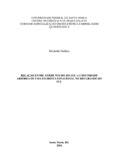| dc.contributor.advisor | Zanini, Roselaine Ruviaro | |
| dc.creator | Dullius, Michelle | |
| dc.date.accessioned | 2017-11-30T13:54:16Z | |
| dc.date.available | 2017-11-30T13:54:16Z | |
| dc.date.issued | 2016-03-14 | |
| dc.date.submitted | 2016 | |
| dc.identifier.uri | http://repositorio.ufsm.br/handle/1/12107 | |
| dc.description | Monografia (especialização) - Universidade Federal de Santa Maria, Centro de Ciências Naturais e Exatas, Curso de Especialização em Estatística e Modelagem Quantitativa, RS, 2016. | por |
| dc.description.abstract | This study was conducted in a Seasonal Subtropical Forest remnant located in Itaara and belonging to the Plateau Border area of the Rio Grande do Sul State, Brazil. The aim was to analyze the pedological factors and verify their relationships with the physiognomy and community structure of the vegetation. We conducted a forest inventory in 23 plots of 200m² (20mx10 m) allocated over four transects systematically distributed 40 meters from each other. During the vegetation description, we recorded only the individuals of the arboreal and shrub stratum of the forest having diameter at breast height (DBH) ≥ 5cm. We performed the identification, DBH measurement and total height of the individuals, the vegetation canopy height, and the soil classification and morphological characterization in each plot. The sampling was composed by 944 arboreal individuals, which belong to 66 species and 32 families, in an area with estimated density of 2052 individuals ha-1. A grouping analysis applied to the recorded data separated the plots in four groups according their pH and soil depth similarities. The species distribution and vegetation structure were associated to soil characteristics, showing significant differences on canopy height and individuals total height among the different pedological groups. These results help to understand the relationship between the vegetation and the forest community substrate. Such knowledge is essential for planning the conservation of natural resources, environmental restoration, and for assessing the effectiveness of the management plans in other similar areas. | eng |
| dc.language | por | por |
| dc.publisher | Universidade Federal de Santa Maria | por |
| dc.rights | Acesso Aberto | por |
| dc.rights | Attribution-NonCommercial-NoDerivatives 4.0 International | * |
| dc.rights.uri | http://creativecommons.org/licenses/by-nc-nd/4.0/ | * |
| dc.subject | Floresta secundária | por |
| dc.subject | Floresta estacional | por |
| dc.subject | Análise multivariada | por |
| dc.subject | Análise de agrupamento | por |
| dc.subject | Cluster | por |
| dc.subject | Secondary forest | eng |
| dc.subject | Seasonal forest | eng |
| dc.subject | Multivariate analysis | eng |
| dc.subject | Grouping analysis | eng |
| dc.subject | Cluster | eng |
| dc.title | Relação entre atributos do solo e a comunidade arbórea de uma floresta estacional no Rio Grande do Sul | por |
| dc.title.alternative | Relationship between soil attributes and the arboreal community of a seasonal forest in Rio Grande do Sul | eng |
| dc.type | Trabalho de Conclusão de Curso de Especialização | por |
| dc.degree.local | Santa Maria, RS, Brasil. | por |
| dc.degree.specialization | Estatística e Modelagem Quantitativa | por |
| dc.description.resumo | O presente estudo foi realizado em um remanescente de Floresta Estacional Subtropical no Rebordo do Planalto do Rio Grande do Sul, em Itaara, tendo como objetivo analisar os fatores pedológicos e verificar suas relações com a estrutura fisionômica e comunitária da vegetação. Para isso foi realizado um inventário florestal em 23 parcelas de 200m² (20mx10m) alocadas ao longo de quatro transectos, distribuídos sistematicamente em intervalos de 40 metros entre si. No levantamento da vegetação foi considerado o estrato arbóreo e arbustivo da floresta e incluídos apenas os indivíduos com diâmetro à altura do peito (DAP) ≥ 5cm. Em cada parcela foram realizadas a identificação, medição do DAP, da altura total e altura de copa dos indivíduos da vegetação e a classificação e caracterização morfológica dos solos. Foram amostrados 944 indivíduos arbóreos pertencentes a 66 espécies e 32 famílias, com estimativa de densidade de 2052ind.ha-1. Para análise destes dados foi utilizada a Analíse de Agrupamentos, a qual separou as parcelas em quatro grupos semelhantes quanto às variáveis pH e profundidade do solo. A distribuição das espécies e a estrutura da vegetação foi associada às características do solo, apresentando diferenças significativas na altura de copa e na altura total dos indivíduos entre os diferentes grupos pedológicos. Esses resultados auxiliaram a entender as relações existentes entre a vegetação e o substrato da comunidade florestal. Tal conhecimento é fundamental no planejamento da conservação dos recursos naturais, restauração ambiental e na avaliação da eficácia de planos de manejo em outras áreas semelhantes. | por |
| dc.publisher.country | Brasil | por |
| dc.publisher.initials | UFSM | por |
| dc.subject.cnpq | CNPQ::CIENCIAS EXATAS E DA TERRA::PROBABILIDADE E ESTATISTICA | por |
| dc.publisher.unidade | Centro de Ciências Naturais e Exatas | por |



